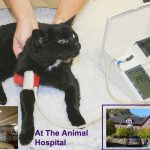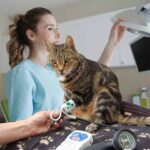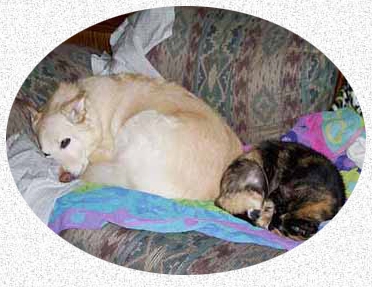High Blood Pressure In Your Dog And Cat – Hypertension
Ron Hines DVM PhD
 How Accurate Are My Pet’s Blood Pressure Readings?
How Accurate Are My Pet’s Blood Pressure Readings?
 More About High & Low blood Pressure
More About High & Low blood Pressure
 In Cats Hyperthyroidism Is One Leading Cause
In Cats Hyperthyroidism Is One Leading Cause
Until recently, veterinarians would rarely measure your pet’s blood pressure during check-ups. That was because the standard arm cuffs used on humans didn’t work well on dogs or cats. Besides, not much research had been done on what the effects of high blood pressure on dogs and cats might be, or even what breed-normal values were. Even today, there are still large gaps to be filled in veterinary knowledge. However, now, with easy access to specialized equipment designed specifically for cats and dogs, obtaining that health measurement is much more common.
There are two forms of generalized high blood pressure, primary hypertension in which there is no identifiable underlying cause and secondary hypertension where some other underlying health issue or issues affecting your pet are responsible. That is why pets with repeated, elevated blood pressure readings need a thorough examination to be sure that there is no underlying health issue responsible for it. Veterinarians believe that the most common underlying causes of high blood pressure in dogs are chronic kidney disease and hormonal imbalances such as Cushing’s disease. Of the two, reduced kidney function is the most common. The most common health issue related to secondary hypertension (the kind where there is some other underlying issue) in cats is hyperthyroidism. The most common causes of unimportant “situational” high blood pressure in pets are apprehension (yours and/or your pets), cuff position, cuff size, measurement apparatus issues, and technique. (read here) Genetics can play a part in elevated blood pressure in dogs too, with more high-strung breeds and endurance hounds tending to have higher breed-normal blood pressure readings. (read here) Less is known about that in cats. (read here)

What Does High Blood Pressure Do To My Pet?
High blood pressure or hypertension is a stealthy disease in all creatures. It causes no pain or changes in your pet’s personality or appearance. Your pet’s appetite does not change. Physical exams and blood work results remain normal until the problem has been present for quite some time. So, there are few ways, other than blood pressure measurements, to detect that a problem is brewing until after some degree of organ damage has already occurred.
Any area of your pet’s body that is rich in small blood vessels (capillaries, arterioles & venules) has the potential to be damaged by hypertension. These tiny blood vessels were only designed to hold blood traveling at very low pressure. When blood pressure within them becomes too high, they are likely to burst or leak, causing damage to the tissues that surrounds them. Dogs and cats rarely if ever suffer the type of bleeding strokes that us humans do – the kind that is brought on by high blood pressure in the brain. Instead, your pet’s kidneys and eyes are more likely to suffer the damage. Occasionally, things reverse. Health issues that limit blood flow to your pet’s kidneys actually causes the hypertension by increasing the production of renin. Whichever the case in your pet, it is quite common for dogs and cats with kidney problems also have some degree of elevated blood pressure.
Most vision loss in older dogs and older cats is not due to high blood pressure. It is due to age-related cloudiness of the lenses of their eyes (“cataracts“) Actually, the correct term is lenticular sclerosis. But occasionally, high blood pressure will cause blindness in dogs and cats by destroying cells in their retinas. In advanced hypertension, your veterinarian’s eye examination might detect unusually “snaky” arteries, retinal swelling or retinal detachments – all of which can be brought on by high blood pressure. So, your vet might referred you to a veterinary ophthalmologist for confirmation. Some veterinarians believe that in about half of these cases in cats, maybe more, the hypertension associated with hyperthyroidism is the underlying cause of these eye changes. Hyperthyroidism is a quite common problem in older, lean cats. It often occurs in association with reduced kidney function (high BUN, high Creatinine, urine that is too dilute). If hyperthyroidism is the underlying cause of cases of high blood pressure in cats has not yet been determined. Hyperthyroidism is known to sometimes have that effect in humans.
Dogs with overactive adrenal glands (Cushing’s disease) are also at a higher risk for high blood pressure. So are pets with diabetes. Read about diabetes in dogs here and in cats here. If routine health examinations of your pet repeatedly detect high blood pressure (not due to excitement or anxiety), there is probably already an underlying health problem causing it. In contrast, it is common for us humans to develop high blood pressure with no detectable underlying health problem found responsible. It is only when high blood pressure in humans remains untreated that problems later develop.
Many veterinarians now screen all older (~7 yr+) dogs and cats for high blood pressure during their yearly health examinations. In older cats, they might suggest a thyroid hormone level assay and follow up with a blood pressure check when that level is abnormally high – a sign of hyperthyroidism. As I mentioned, it is also a good idea to have your pet’s blood pressure checked when abnormalities are detected in the retinas of your pet’s eyes. Any time your cat or dog appears to be unable to see clearly, ask your vet to examine the deep portions of its eyes with an ophthalmoscope and check its blood pressure as well. If it is an elderly pet, or circles or appears disoriented, have it checked for evidence of dementia as well. Some veterinarians believe that high blood pressure in pets also increases their risk of forming small, difficult-to-detect, blood clots.

How Will My Pet’s Blood Pressure Be Measured?
As I mentioned previously, the traditional cuff and stethoscope method your doctor uses on you, doesn’t work well on your pet. The cuff portion works satisfactorily on your pet’s lower front leg or tail, but veterinarians can’t hear the sounds of the passing blood adequately through the types of stethoscopes your doctor and they use. Hair, variations in arm size, motion and different blood vessel anatomy all interfere with that. But it was found that a sensitive sound-sensing machine called a doppler will pick up the passing sound of rushing blood. It is accurate enough to pick up the first, the systolic pressure sound (the higher number) when evaluating your pet. It does not yet detect the second or diastolic pressure sound very accurately. So, veterinarians in general practice rely primarily on the systolic reading. There are ways to obtain the second (lower) number or sound (the diastolic pressure), but they are complicated and invasive. Even then, getting a reliable systolic blood pressure reading in cats and dogs during your pet’s animal hospital visit is very challenging. It requires experienced technician assistance and the calculation of the average reading in a series of readings – often throwing away the first or even the second result hoping for anxious pets to calm down. Sometimes the hair below the instrument must be clipped. Blood pressure readings tend to be most accurate when you are present to reassure your pet and keep it calm. At best, it delivers a “soft” number that may or may not be representative of your dog or cat’s true, at-home, blood pressure – any more than your pet’s pulse rate at the animal hospital is representative of its heart rate at home. You can take your pet’s pulse rate. If your dog or cat’s pulse is higher at the animal hospital than when your pet is relaxed at home, it is quite likely that the blood pressure readings obtained at your animal hospital are off by about the same percentage. Both are under control of the same nerves and hormones released during anxiety (the “white coat effect”) and exertion. (read here) Read more about falsely high blood pressure readings. A house call vet might be another option.
Many veterinarians believe that a relaxed dog’s systolic blood pressure should not be higher than ~ 160 mmHg. A relaxed cat’s normal blood pressure is thought to be ~ 120 -140 mmHg. But the inaccuracies of the doppler and oscillometric techniques, breed and temperament differences make precise “normal” blood pressure figures quite difficult for me to to give you when your pet is in an animal hospital setting. When diastolic pressure (the lower number) is accurately obtained (as it might be in a university veterinary facility) it has been reported that it should not exceed 83 or 100 mmHg in dogs and cats respectively when they are relaxed and in normal health. Most veterinarians believe that when sustained systolic pressure reaches 180, some degree of organ damage is likely to occur in your pet. (read here)
We can’t just give your cat or your dog a tranquilizer to calm it down. Tranquilizers have the ability to lower blood pressure readings on their own. So, many veterinarians will discard your pet’s highest and the lowest reading they have obtained that day and then take an average of the rest to come up with a value. Others just ignore the first few readings. As I mentioned, sight hounds (greyhounds, afghans, etc.) overweight and older animals tend to have higher readings.

What Signs Might I See In My Dog Or Cat That Indicate High Blood Pressure?
I mentioned that there is no pain associated with high blood pressure. So, indications, if any, will often be subtle or absent. A rapid heart rate, blood surging into a blood collection tube, dilated pupils, vision problems, an enlarged thyroid gland, lumpy kidneys, nose bleeds, and blood in the urine might be clues to your veterinarian that a blood pressure reading is in order. But there are many other possible causes other than hypertension that could account for any of them. In most cases, your veterinarian will suspect high blood pressure because of your pet’s age, evidence of another disease known to cause hypertension or because it was picked up by chance on a routine blood pressure screening. As I mentioned, if your pet is a cat, the diagnosis may have been hyperthyroidism based on a blood analysis of its T4 level, its age and physical appearance (lean pet), vision problems, behavior, thirst or weight loss. (read here) If your pet is a dog, it may have been signs associated with diabetes or the dog’s kidneys or adrenal glands.

What Should I do If My Pet Has High Blood Pressure?
The first thing to do is to redo the test, preferably in a different setting, so that you can eliminate fear, anxiety and stress as the underlying cause. If its systemic blood pressure is still high on repeated tests, some other tests need to be run to identify the underlying cause of the hypertension. Those are often kidney, liver or hormone-related tests. An ultrasound examination is always wise.
The most common medication used to treat high blood pressure in cats and dogs are amlodipine and telmisartan. (read here) Amlodipine belongs to a group of medications called calcium channel blockers. Those medications allow your pet’s blood vessel walls to relax so that more blood can pass through them at a lower pressure. Telmisartan acts by blocking a hormone that increases blood pressure (angiotensin) in a similar way. Enalapril and benazepril, drugs belong to a group of drugs called ACE-inhibitors, are also sometimes effective to lowering blood pressure in dogs and cats. They have been used for years in humans and animals to ease the workload of your pet’s heart by decreasing vascular resistance. Enalapril was first marketed as Vasotec® for humans and Enacard® for pets. But it is now off-patent and available in less expensive generic forms. The problem with relying on ACE inhibitors to lower blood pressure is that their effects on kidney function are complex and poorly understood. However, most studies have found them to be beneficial. Just keep track of your pet’s BUN and Creatine levels, urine specific gravity and urine microalbumin content as time goes by.

It can be quite difficult or nearly impossible to get cats to swallow these and other medications in pill form. And even if you do succeed, pills and capsules can become stuck (become lodged in their esophagus) halfway down to their stomach, causing ulceration, scaring and damage. These medications are best crushed into a fine powder, then mixed with a flavorful paste or a liquid and then given orally with a syringe. Better yet, custom compounded by a specialty pharmacy into a more peasant tasting liquid formula (beef, bacon, chicken or cheese for dogs, tuna, salmon, shrimp or sardine for cats). These drugs have occasionally improved the vision of cats suspected to have been caused by high blood pressure. When receiving channel blockers or ACE inhibitors, your pet’s kidney function should be regularly monitored.
Another group of drugs that may help reduce blood pressure in your dog or cat are the beta-adrenergic blockers, propranolol (Inderal®) or atenolol (Tenormin®). They work by slowing your pet’s heart rate. Diuretics such as furosemide (Lasix®) or spironolactone (Aldactone®, etc.) might also be employed to decrease your pet’s blood volume and, in so doing, lower its blood pressure. Others suggest the blood vessel dilator (vasodilator), hydralazine (Apresoline®) for the same effect. I have no experience using any of those drugs in dogs or cats – do so only under the advice of a veterinary nephrologist.
Some veterinarians also recommend a low salt diet for your pet if its blood pressure is high. Theoretically, that might decrease water retention and blood volume and, perhaps, in that way, lower your dog or cat’s blood pressure. Although there is very little or no scientific evidence that salt-restricted diets have any positive or negative effect on blood pressure in cats or dogs. (read here & here) many commercial veterinary diets advertise their lower salt content. There is certainly no harm in trying a moderately salt-restricted diet for your pet if you wish. If that alone lowers your dog or cat’s blood pressure, let me know and I will spread the word. Specialty diets designed for failing kidneys or hearts are probably most suitable in that regard. (read here) Of course, your dog, or cat must be willing to eat those diets so as not to lose healthy weight.
So now you know that there is no one-standard-protocol or treatment plan for high blood pressure in dogs and cats. Your veterinarian will suggest the treatment plan that has worked best for him/her in similar cases in the past. In pets with confirmed high blood pressure, I suggest you have its blood pressure rechecked (at the same facility, same machine and by the same person) three weeks after beginning any therapy or a change in medication dose and then three or four times a year to see if it is helping. You can also check your blood pressure at home, which is probably a much better option. (read here) I have no idea as to the accuracy of the low-cost pet blood pressure devices that are now so easy to purchase.
You are on the Vetspace animal health website
Visiting the products that you see displayed on this website help pay the cost of keeping these articles on the Internet.


